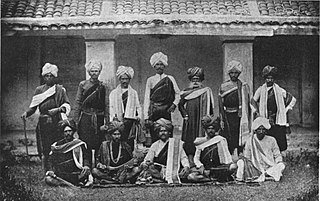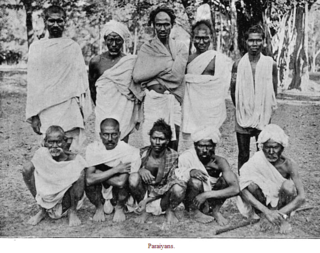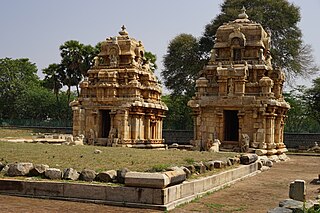| Regions with significant populations | |
|---|---|
| Tamil Nadu, India | |
| Languages | |
| Tamil | |
| Religion | |
| Hinduism | |
| Related ethnic groups | |
| Tamil people |
Koliyar is one of the artisan castes of the ancient Tamil society. [1] They are a community of weKolis who were regularly mentioned in medieval Tamil inscriptions. [2] They were classified together with the Taccar (carpenters, stonemasons etc.), Kollar, and Tattar as constituting the Kilkalanai group. According to historian K.V Subrahmanya Iyer, this term referred to the Sanskrit Anuloma. [3] Koliyars are Surya Kula by Origin and Claim descendancy from Koliyas
They seem to have been a powerful and influential group during the period of the Cholas as we find many sovereigns assuming titles such as Koliyar-Ko (King of Koliyar), Koliyar-Kula-pati (head of Koliyar), etc. so much so that historians sometimes use the term Koliyar as a synonym for the Cholas. [4] [5]
It is of interest to note that Uraiyur, the early Chola capital was also known as Koliyur. [6] Though it is generally presumed to be named after the City of fowl or cock, it perhaps takes its name after this once popular community. [7]
The Koliyas Gotta is mostly Shiva Gotra and they mainly follow pattam Or Clan to identify their lineage. Their culture is unique in its own way but has in link many aspects of Mukkulathar, Mutharaiyar and Paraiyars and other Communities. Despite their claim being migrants from North india their culture and language is well assimilated and indistinguishable from the natives. The place they live is called Nadu which is further divided into grammar or kurram. Their Kula Deivam mainly includes Aiyanar, Pattavanswami, and Pothiamma and other deities. Their settlements are found mostly along with Kallar, Ambalakkarar, Asari

Uttama, also known as Madhurantaka, Uthaya Kumar, was a Chola Emperor who ruled from 970 CE to 985 CE in present-day Tamil Nadu, India. According to Tiruvalangadu plates of Rajendra Chola, Madhurantaka Uttama's reign is placed after Aditya II. The latter may have been a co-regent of Parantaka II and seems to have died before he could formally ascend the throne. Uttama was the cousin of Parantaka II and was the son of the illustrious Sembiyan Mahadevi and Gandaraditya.

The Pallava dynasty existed from 275 CE to 897 CE, ruling a significant portion of the Deccan, also known as Tondaimandalam. The Pallavas played a crucial role in shaping in particular southern Indian history and heritage. The dynasty rose to prominence after the downfall of the Satavahana Empire, whom they had formerly served as feudatories.

Kulottunga Chola I also spelt Kulothunga, born Rajendra Chalukya, was a Chola Emperor who reigned from 1070 to 1122 succeeding his cousin Athirajendra Chola. He also served as the Eastern Chalukya monarch from 1061 to 1118, succeeding his father Rajaraja Narendra. He is related to the Chola dynasty through his mother's side and the Eastern Chalukyas through his father's side. His mother, Ammangaidevi, was a Chola princess and the daughter of emperor Rajendra Chola I. His father was king Rajaraja Narendra of the Eastern Chalukya dynasty who was the nephew of Rajendra and maternal grandson of Rajaraja Chola I. According to historian Sailendra Nath Sen, his accession marked the beginning of a new era and ushered in a period of internal peace and benevolent administration. He was succeeded by his son Vikrama Chola
Kaarkaathaar is a subcaste of Vellalar Hindu caste in the Indian state of Tamil Nadu.
Saliya or Saliyar is a South Indian Hindu caste. Their traditional occupation was that of weaving and they are found mostly in the regions of northern Kerala, southern coastal Karnataka, Andhra Pradesh, Tamil Nadu as well as Maharashtra and Madhya Pradesh.

The Chera dynasty, was a Sangam age Tamil dynasty which unified various regions of the western coast and western ghats in southern India to form the early Chera empire. The dynasty, known as one of the Three Crowned Kings of Tamilakam alongside the Chola and Pandya, has been documented as early as the 4th to 3rd centuries BCE. Their governance extended over diverse territories until the 12th century CE.

Vokkaliga is a community of closely related castes, from the Indian states of Karnataka and Tamil Nadu.
Vellalar is a group of castes in the Indian states of Tamil Nadu, Kerala and northeastern parts of Sri Lanka. The Vellalar are members of several endogamous castes such as the numerically strong Arunattu Vellalar, Chozhia Vellalar, Karkarthar Vellalar, Kongu Vellalar, Thuluva Vellalar and Sri Lankan Vellalar.
Gandaraditha Chola succeeded his father Parantaka I and became the Chola king about 955 CE. He was also a Tamil literary poet in the Thiruvisaippa Palandu. He had a son named Madurantaka Chola also known as Uttama Chola, who became Chola emperor after his cousin Sundara Chola.
Parantaka II was a Chola emperor. He is also known as Sundara Chola as he was considered an epitome of male beauty. He was the son of Arinjaya Chola and queen Kalyani, a princess of Vaidumba family. Parantaka II ascended the Chola throne despite the fact that his cousin Madurantaka Uttama Chola, the son of Gandaraditya Chola was alive and he had equal if not more claim to the Chola throne. During his reign, Parantaka Sundara Chola defeated the Pandyas and Ceylon and then recaptured the Tondaimandalam from Rashtrakutas.

Paraiyar, Parayar or Maraiyar is a caste group found in the Indian states of Tamil Nadu and Kerala and in Sri Lanka.

Karikala, often referred to as Karikala the Great, was a Tamil Emperor of the Early Cholas of the Chola dynasty who ruled ancient Tamilakam from Uraiyur. He is credited with the construction of the flood banks of the river Kaveri and conquest of Tamilakam, Andhra and Sri Lanka. He is recognised as the greatest of the Early Cholas. In Thiruvalangadu plates of Rajendra Chola I, Medieval Tamil Cholas listed Karikala Chola as one of their ancestors.

Vikrama Chola, known as Kō Parakēsari Varman, was a 12th-century ruler of the Chola Empire in southern India. He succeeded his father Kulothunga I to the throne. Vikrama Chola was crowned as the heir-apparent by his father early in his life. He was appointed as viceroy of the Vengi province in 1089 C.E., succeeding his brother Rajaraja Chodaganga. Vikrama during his tenure successfully managed to check the ambitions of the Western Chalukya Vikramaditya VI on the Vengi kingdom.Vikrama Chola inherited the territories which included Tamil Nadu and some parts of Andhra Pradesh.

Sengunthar, also known as the Kaikolar and Senguntha Mudaliar is a caste commonly found in the Indian state of Tamil Nadu, Andhra Pradesh and the neighboring country Sri Lanka. In Andhra Pradesh, they are known as Kaikala or Karikala Bhaktulu, who consider the early Chola emperor Karikala Chola as their hero. They were Warriors of Cholas and Traditionally Textile Merchants and Silk Weavers by occupation They were part of the Chola army as Kaikola regiment and were dominant during the rule of Imperial Cholas, holding commander and minister positions in the court. Ottakoothar, 12th century court poet and minister of Cholas under Vikrama Chola, Kulothunga Chola II, Raja Raja Chola II reign belong to this community. In the olden days in India, the Sengunthars were warriors and were given the title Mudaliar for their bravery. In early thirteenth century, after the fall of Chola empire large number of Kaikolars migrated to Kongu Nadu from Tondaimandalam and started doing weaving and textile businesses as their full time profession as they sworn to be soldiers only for Chola emperors. At present, most of the textile businesses in Tamil Nadu are owned by Senguntha Mudaliars. Majority of Sengunthars are sub-divided into numerous clans based on a patrilineal lineage known as Koottam or Gotra.

The Velir were a royal house of minor dynastic kings and aristocratic chieftains in Tamilakam in the early historic period of South India. They had close relations with Chera, Chola and Pandya rulers through ruling and coronation rights. Medieval inscriptions and Sangam literature claim that they belong to the Yadu dynasty. Velir may refer to master of land.

The Tondaiman family were Tamil rulers of the ancient Tondai Nadu (Tondaimandalam) division of Tamilakkam in South India. Their capital was at Kanchipuram.

Karunakara Tondaiman was a general of Chola Emperor Kulottunga I. He is renowned for leading the Chola invasion of Kalinga during the reign of Kulottunga I and is the hero of Jayamkondar's poem Kalinkkattuparani In the Parani poem he is referred to as the lord of Vandai. while in the Draksharamam inscription of Kulottunga I, he is called as Vanduvaraja and Pallavaraja. He also served as a minister under Kulothunga Chola's son and successor, Vikrama Chola.

Irunkōvēl, also known as Irungkōvēl, Irukkuvēl, and Ilangōvēlir, was a title of the Irunkōvēl line of Velir kings. The Irunkovel line of kings ruled over Konadu identified with the Kodumbalur and surrounding areas in ancient Tamilakkam. They trace their lineage to the clan of Krishna; one of the inscriptions at Kodumbalur belonging to one of the kings in the Irunkovel line, namely Tennavan Irunkōvēl alias Maravan Bhutiyar. They belong to Kallar family, K. A. Nilakanta Sastri mentions in his study.
Pattanavar is a Tamil caste found in Tamil Nadu, India.
Manimangalam is a small town located in the Kanchipuram district of Tamil Nadu state in Southern India, famous for its ancient temples and inscriptions documenting the history of the ancient Tamil kings
{{cite book}}: CS1 maint: multiple names: authors list (link)